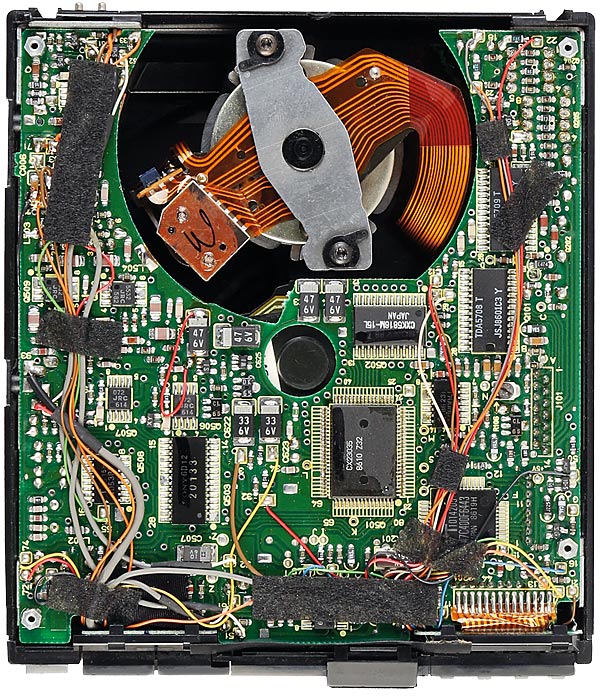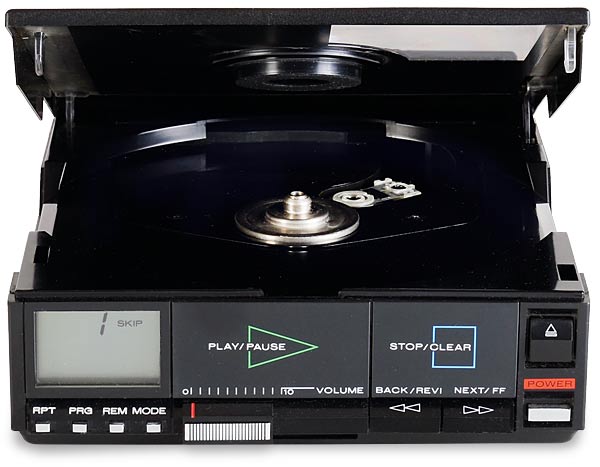Philips CD10 portable Page 2
Yes, one could imagine that if the player was to be carried gently to a sturdy table, placed ever so carefully down and not knocked in any way then a CD could be enjoyed outside (that is, until the six 'C' sized alkaline batteries were gobbled up, and that doesn't take that long). But this rather defeats the object of a portable model like this. It's a shame, as the audio performance of the Philips CD10 is quite a surprise.
![]() Tim Listens
Tim Listens
Perhaps the most remarkable thing about the sound of the CD10 is how similar it is to that of a full-size Philips player, eg, the CD104 [HFN Apr '14], despite it having no digital filter and only one DAC.
Critical listening reveals the expected rather chaotic imaging that many single-DAC players tend to exhibit as opposed to the usual Philips architectural solidity, but tonally the characteristic smoothness and richness are still there. Furthermore, since the imaging problems are nowhere near as evident when the player is heard via headphones as they are through a pair of loudspeakers, this could have been an almost ideal product – something akin to a pocket-sized Marantz CD-73 [HFN Mar '19].

Exactly how this performance was achieved remains a mystery. The layout of the CD10's analogue sections is very similar to that found in the D-50's while some parts, such as the DC-coupled driver stage for the headphone output, are identical. Despite this, the CD10 offers a distinct improvement over the Sony D-50 and its in-house derivatives, which sound brittle and strident by comparison. Overall, the CD10 is best described as having a 'big' sound when used with a hi-fi system, recordings being reproduced with a similar sense of scale to that which one is accustomed from equipment designed with no significant constraints on either size or consumption of power.
Sit back and listen to something like Katie Melua's 'Mockingbird Song' from her album Call Off The Search [DRAMCD0002] and you'll find the CD10 to be as rich and fluid-sounding as the D-50 is fast and focused. As is often the case with old Philips players, the bass guitar sometimes got in the way of the rest of music with its big, lazy sound but vocal rendering was excellent and displayed fine clarity.
Smooth Strings
In fact, only a shrunken soundstage in which the various parts of the mix appeared as smears instead of pinpoints gave away that this wasn't one of the old 14-bit classics. Similar effects were noted when playing orchestral pieces, Strauss's Don Juan [BPO/Karajan: DG 447 441-2] thrilling with its sound when played on the CD10, the perceived smoothness of the strings in particular allowing the entire piece to be enjoyed at a realistic volume level without listener fatigue.
Only the most delicate solo violin sections revealed a lack of ultimate refinement when compared to a full-sized 'reference' player, this taking the form of a coarseness not dissimilar to that heard from a worn LP. This became inaudible again during the louder sections of the piece, but once 'tuned in to' I'll admit to finding it difficult to ignore.

Still, overall the CD10 performed well given its basic underpinnings. Family members who heard it were impressed with its performance too; it's just a shame that it proved to be so impractical in its intended portable role.
Buying Secondhand
While Philips CD10s are relatively easy to find on the secondhand market, fully working examples are harder to come by. Due to the player's small size, all repairs are extremely difficult and must be conducted with great care. For example, remove the main PCB carelessly and the chances are that you will tear the flexi-PCB to the laser, thereby ruining the machine before you even start.
The CDM-2P optical unit looks familiar but it shares virtually no common components with the regular CDM-2, so replacement parts are difficult to obtain. As with all CDM-2s, the fixed lens below the moving objective (eg, the one you can see) can come unglued, making for erratic reading of the disc. Repairs are possible, but this is by no means a task for a beginner. Laser failure through wear is much less common. This is because portables typically don't run for the same amount of time as their full-sized counterparts and the basic design of the CDM-2 family is famously sturdy.

Problems with the hall sensors in the spindle motor can occur, but like everything else they are tiny and difficult to get to. Elsewhere, problems with the electrolytic capacitors inside the DC-DC converter can cause all manner of odd symptoms, but since access to these involves a near complete stripdown of everything, problems in this area are best confirmed by examination of the output voltages before repairs are attempted.
One simple problem is that the metal trim on top of the lid can become detached, causing the lid to flex and so prevent the interlock switch from operating correctly. Once the old film adhesive is removed it is easy to glue the metalwork back in place, but be careful to do a neat job as the results are visible from underneath when the lid is open. Incidentally, don't waste your time trying to track down a pair of the original headphones. They were nothing to write home about.
Hi-Fi News Verdict
An unlikely mix of Philips, Marantz and Sony ideas, the CD10 was always going to be an interesting design. Soundwise the player proves that there was more to the dominance of Philips than oversampling and digital filters – the designers could even make Sony's chips sound like their own. An intriguing machine, then, and one capable of making sweet music, but not a player for beginners if repairs are required.























































